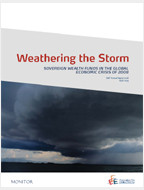FEEM-Monitor SWF Annual Report 2008
From the Editors Bernardo Bortolotti, FEEM Executive Director and William F. Miracky, Senior Partner, Monitor Group.
Since global markets fi rst recognized the growing phenomenon of sovereign wealth funds (henceforth SWFs), these funds have been controversial. Initially depicted as scary new “barbarians at the gate” shaking the logic of capitalism, SWFs quickly turned into the white knights of Wall Street as the subprime crisis started to hit hard. The synchronic worldwide recession triggered by the market crash provided an automatic stabilizer of the global imbalances partly responsible for the rise of sovereign wealth, and today the funds are no longer seen as something to be dreaded and their activities no longer routinely make headlines. However, with assets worth more than $2 trillion, SWFs are likely to remain important sources of liquidity to a distressed global economic system.
Interestingly, the public fi restorm on SWFs ignited with limited fact-based information about what they really are, how many assets they manage, where they invest, and how they operate. True, the lack of transparency of most funds contributed to the controversy, but their prominence in the media and in the policy agenda dwarfed the available knowledge on this new and challenging phenomenon.
A small group of front-runners, and certainly Monitor ranks among them, started to fi ll this information gap. The research community reacted more slowly, but started to produce a fi rst batch of studies using the scarce data and information publicly available. However, it became quickly apparent that the benefi t from joint work and mutual sharing of data and information of such a new and complex phenomenon could be substantial.
This is the logic underlying the partnership between FEEM and Monitor Group that we are launching today with this joint SWF Annual Report. We have united forces to create one of the largest and most comprehensive databases on global SWF deals using publicly available data. This has been achieved by setting forth a rigorous defi nition of SWFs, by merging and cross-checking the two existing databases which have been independently assembled, and by streamlining our routines for the collection and screening of data to monitor current and future SWF investment.
The result is a rich source of information about SWFs. The Monitor-FEEM SWF Transaction Database contains 1,158 deals completed by 17 funds in 11 countries for the period between January 1, 1981 and December 31, 2008, and will be regularly updated on a quarterly basis.
We are pleased to present to the reader the fi rst issue of our joint SWF Annual Report, covering SWF activity during 2008 and using the newly created database. The report aims to provide descriptive information about the recent trends with additional insights gained from ongoing research produced in-house and externally. Accordingly, we feature contributed articles by our team and from renowned international experts. We are particularly pleased to host in this issue an article by Andrew Rozanov, an investment banker and fi nancial analyst who is universally recognized as a leading fi gure in the study of SWFs. Indeed, he coined the term in his path-breaking article “Who owns the wealth of nations?” (2005). The report also boasts an interesting article by Paola Subacchi from Chatham House, the well known London-based think tank, which has also tracked the evolution of SWFs since the early days.
The report shows not only that the global economic crisis has manifested a profound effect on investment strategies in 2008 but also quantifi es this effect and enables us to offer the following conclusions.
- Despite the crisis, the volume of investment activity remained substantial, though the total dollar value of SWF deals declined later in the year, dropping from $67.8 billion in Q1 of 2008 to $35.1 billion in Q4.
- During the crisis, SWFs lost at least $57.2 billion on paper from their initial investments, as demonstrated by Fotak, Megginson, and Li. This SWF performance is driven primarily by their large exposure to the fi nancial services sector, but also likely due to unfortunate stock picking or a tendency to invest in distressed industries as a way to minimize political or PR opposition.
- Nonetheless, and despite representing a declining share of overall deal activity, the fi nancial services sector continued to be an important target for SWF investment. In 2008, it accounted for 28 percent of the deals, worth 75 percent of the total value ($96.2 billion).
- As the year progressed and the economic crisis spread, many funds importantly shifted their investment strategies, retreating from distant markets and increasing domestic and regional investments, particularly in emerging markets. In Q4 of 2008, as funds sought to prop up local economies, domestic investment by SWFs made up over 40 percent of all deals, the highest level since 2002. In the same quarter emerging markets investments amounted to over 70 percent of SWF deal value for the fi rst time since 2004.
- The crisis has put a brake on SWF growth, so that projections made during 2007 now appear overly optimistic, as Subacchi argues. Reduced export revenues and oil prices suggest that assets under SWF control will reach $5-6 trillion by 2012, rather than the $10 trillion to $12 trillion previously forecast.
- In the future, SWFs seem likely to prefer investing for sustainability and the long term rather than for higher risk-adjusted returns from equities in developed market economies.

